You can boost your running performance by tracking your VO2 max, which measures your body’s maximum oxygen consumption during intense exercise. This key metric helps you establish precise training zones, monitor cardiovascular improvements, and predict race performance potential. Wearable devices now estimate VO2 max with impressive 5.7% accuracy compared to lab tests, making this powerful training tool accessible for everyday runners. Understanding how to leverage this data will reveal your true running potential.
What Is VO2 Max and Why Runners Need to Know About It
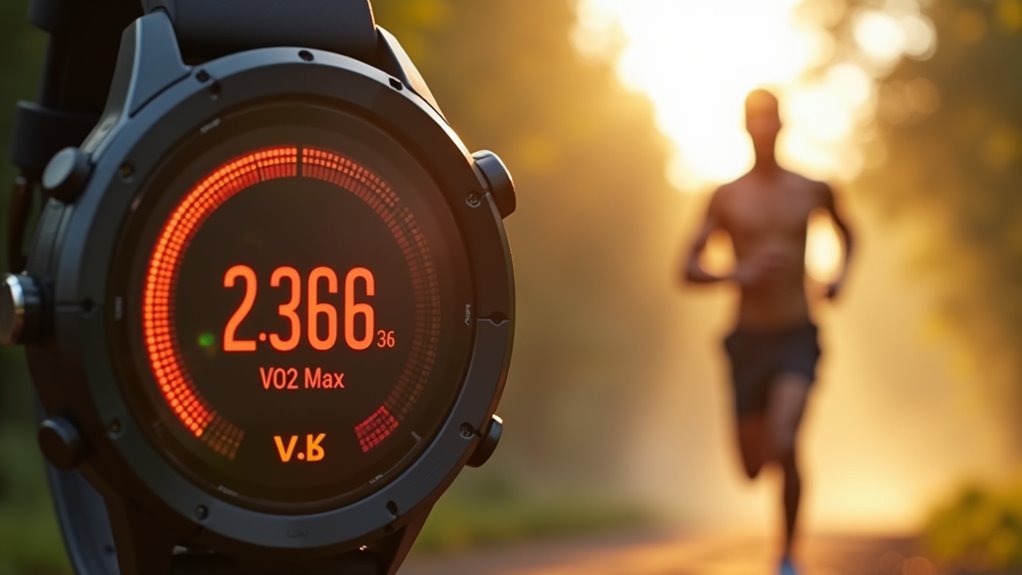
Imagine this: you’re midway through a challenging run when your breathing becomes labored and your legs start to feel heavy. What you’re experiencing relates directly to your VO2 max—the maximum rate of oxygen your body can utilize during intense exercise.
VO2 max, short for “volume of oxygen maximum,” measures how efficiently your cardiovascular system delivers oxygen to working muscles. It’s expressed in milliliters of oxygen per kilogram of body weight per minute (ml/kg/min).
For runners, VO2 max serves as an essential performance indicator. Higher values typically mean you’ll sustain faster paces longer and recover more efficiently.
It helps determine your training zones, track fitness progress, and predict race performance. Beyond running, it’s also a valuable health metric that reflects your overall cardiovascular fitness and is linked to increased life expectancy in both healthy individuals and those with heart conditions.
The Science Behind VO2 Max Measurement in Laboratory Settings
When you step into a laboratory for VO2 max testing, you’ll encounter sophisticated equipment designed to measure your body’s oxygen consumption with scientific precision.
The testing typically involves running on a treadmill or cycling while wearing a metabolic mask that’s connected to a metabolic cart, which continuously analyzes the oxygen you consume and carbon dioxide you produce.
This real-time gas analysis allows researchers to calculate your exact VO2 max by measuring how much oxygen your body utilizes per minute relative to your body weight. During the test, the intensity progressively increases until you reach complete exhaustion, ensuring an accurate measurement of your maximal oxygen consumption capacity.
Laboratory Testing Equipment
Laboratory testing equipment represents the gold standard for VO2 max measurement, delivering precise data that consumer devices can’t match.
You’ll encounter metabolic carts as the primary testing devices, integrating breath analysis with gas exchange measurement. These systems perform real-time breath-by-breath analysis, capturing your oxygen consumption and carbon dioxide production during exercise.
You’ll exercise on standardized treadmills or cycle ergometers while connected to sophisticated analyzers. Modern portable VO2 systems eliminate bulky hoses and cables without sacrificing lab-quality accuracy. These lightweight designs promote comfort and freedom of movement during testing sessions.
The equipment monitors cardiovascular parameters including ECG and oxygen saturation for safety. Proper calibration of gas analyzers and flow sensors guarantees precise measurement of your inspired and expired gases, while detecting anaerobic thresholds provides insights into your exercise intensity zones.
Oxygen Analysis Process
Behind this sophisticated equipment lies a precise oxygen analysis process that transforms your breath into meaningful performance data.
When you exercise during VO2 max testing, you’ll breathe through a specialized mask or mouthpiece connected to gas analyzers. These devices continuously measure oxygen and carbon dioxide concentrations in your inhaled and exhaled air.
The system calculates your oxygen consumption by comparing the difference between what you breathe in versus what you breathe out. As exercise intensity increases incrementally, the analyzers track your body’s peak oxygen uptake capacity.
This real-time data collection typically continues for 8-12 minutes until you reach maximal effort. The highest recorded oxygen consumption value becomes your VO2 max, providing vital insights for optimizing your running performance. The results are expressed in milliliters per kilogram per minute, giving you a standardized measurement of your cardiovascular fitness level.
How Wearable Devices Calculate Your VO2 Max During Runs
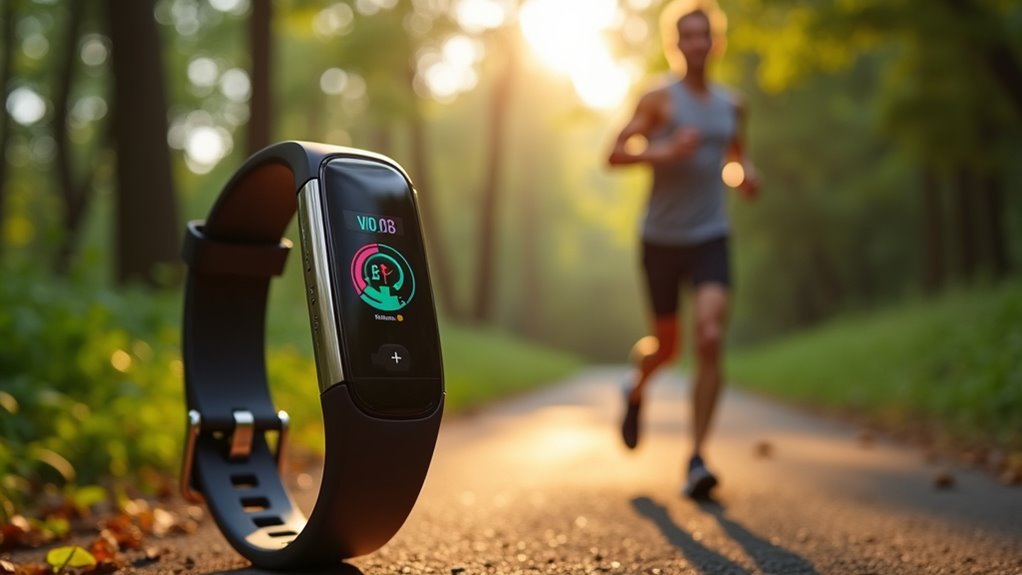
As you lace up your running shoes and head out for your workout, your smartwatch begins collecting a complex array of data points to estimate your VO2 max in real-time. Your device monitors your heart rate continuously while tracking your running pace and distance covered.
GPS data helps assess your workout intensity levels as algorithms process this information. Companies like Garmin use FirstBeat analytics to predict your VO2 max, while Apple Watch relies on outdoor running tests combined with heart rate data.
These calculations consider person-specific factors that can affect accuracy. While studies show wearables achieve around 5.7% mean absolute percentage error compared to lab tests, they’re still valuable for tracking fitness trends. One limitation is that these devices don’t account for environmental factors like humidity and temperature that can impact your performance during runs.
VO2 Max as a Predictor of Running Performance and Race Times
Your VO2 max reading doesn’t just reflect your current fitness level—it’s actually one of the strongest predictors of how you’ll perform in races. Research consistently shows significant correlations between VO2 max values and race times, especially for longer distances where aerobic capacity dominates performance.
The predictive power becomes even stronger when you consider velocity at VO2 max (vVO2max), which often serves as the best predictor for shorter races like 5Ks. Among elite runners with similar training backgrounds, VO2 max differences can explain varying race performances.
| Distance | VO2 Max Correlation | Key Factors |
|---|---|---|
| 5K-10K | Strong | vVO2max, running economy |
| Half Marathon | Very Strong | Sustained aerobic capacity |
| Marathon | Moderate-Strong | Economy, fuel efficiency |
However, VO2 max isn’t everything—running economy, strategy, and course conditions also influence your final times. Understanding that low VO2max significantly limits achievable performance levels helps explain why improving your aerobic capacity remains fundamental for competitive running success.
Cardiovascular Health Benefits of Higher VO2 Max Values

Beyond optimizing your race performance, maintaining higher VO2 max values delivers profound cardiovascular health benefits that extend far beyond the finish line.
Each 1-MET increase in your VO2 max reduces cardiovascular disease mortality risk by 13%, making it a reliable predictor of heart health outcomes. You’ll experience improved cardiac output and blood vessel efficiency, leading to lower resting heart rate and blood pressure.
Higher VO2 max values considerably reduce your risk of stroke, type 2 diabetes, and cardiovascular hospitalizations. Even modest improvements in VO2 max can delay heart failure symptoms and enhance overall longevity.
You’ll also enjoy better quality of life through increased energy, improved mental health, and enhanced cognitive function as your cardiovascular system becomes more resilient. Training adaptations improve your body’s oxygen transport efficiency to working muscles during physical activity.
Using VO2 Max Data to Design Effective Training Programs
When you transform VO2 max data from a simple fitness metric into a strategic training tool, you’ll gain access to the ability to design programs that deliver measurable improvements rather than relying on guesswork. Your baseline VO2 max establishes precise heart rate zones and training thresholds for personalized workload calculations.
| Training Component | VO2 Max Application |
|---|---|
| Interval Intensity | Calculate exact effort based on VO2 max percentage |
| Recovery Planning | Monitor fatigue trends to schedule ideal rest days |
| Circuit Training | Design 30-60% 1-RM workouts at 60-80% max heart rate |
| Progressive Protocols | Track power output improvements across 10-week cycles |
You’ll prevent overtraining by monitoring cardiovascular stress while identifying plateaus through objective data rather than subjective feelings. Implementing interval training with sessions at or above your anaerobic threshold maximizes aerobic power development for significant VO2 max gains.
High-Intensity Interval Training for Maximum VO2 Max Gains
When you’re ready to maximize your VO2 max gains, designing effective HIIT protocols becomes your most powerful tool.
You’ll need to target specific training intensity zones, typically working at 85-95% of your maximum heart rate to trigger the adaptations that drive meaningful improvements.
The key lies in structuring your intervals with the right combination of work duration, recovery periods, and intensity to create the ideal stimulus for cardiovascular enhancement.
Research demonstrates that the 4×4 minute protocol delivers 10% increases in VO2 max, making it the most effective interval training method for aerobic capacity development.
HIIT Protocol Design
Since traditional moderate-intensity training only delivers 6.0% VO2 max improvements, you’ll want to leverage HIIT’s superior 9.4% gains through strategic protocol design.
Design your intervals using a 3:2 work-to-recovery ratio to maintain near-maximal effort levels. Focus on long intervals (≥2 minutes) with high-volume sessions (≥15 minutes) for peak VO2 max gains over 4-12 weeks. Most athletes can typically handle only 2-3 high-intensity sessions per week due to the demanding nature of these workouts.
Consider implementing HIDIT protocols that start with longer intervals (3 minutes) and progressively decrease to shorter ones (30 seconds). This approach maximizes time spent above 90% VO2 max while creating a priming effect for faster improvements.
Customize intensity and volume based on your fitness level, ensuring thorough warm-ups and cool-downs to reduce injury risk while maximizing cardiovascular adaptations.
Training Intensity Zones
Protocol design sets the foundation, but training intensity zones determine whether you’ll actually reach those impressive VO2 max gains.
You’ll need to train at 90-100% of your maximal heart rate to trigger the physiological adaptations that boost oxygen uptake efficiency. This high-intensity zone stimulates both central adaptations like increased cardiac output and peripheral changes including enhanced mitochondrial density.
You can monitor your intensity using heart rate zones, power output metrics, or rate of perceived exertion reaching 17-19 on a 20-point scale.
During proper VO2 max intervals, you’ll experience lactate concentrations of 8-12 mmol/L, confirming you’re hitting the target zone. This precise intensity maximizes improvements in capillary density, enzymatic activity, and oxygen extraction efficiency that translate to better endurance performance. Effective interval durations can range from 3-10 minutes depending on your target intensity and current fitness level.
Combining Continuous and Interval Training for Optimal Results
While high-intensity interval training alone delivers superior VO2 max improvements compared to continuous aerobic exercise, combining both methods creates an even more powerful approach to boosting your running performance.
You’ll maximize your aerobic capacity by alternating between interval and continuous training days throughout your weekly routine.
Structure your intervals with 3-10 minute sessions at high intensity near your VO2 max threshold, then complement these with long slow distance runs on alternate days.
This combination prevents training plateaus by providing varied stress stimuli that enhance both cardiac strengthening and muscle oxygen uptake.
You can achieve significant improvements with less than 2.5 hours of weekly training when you strategically blend both methods, creating sustained VO2 max increases while improving running economy and overall endurance performance. Inactive individuals may notice meaningful improvements in their VO2 max within just 4-6 weeks of starting this combined training approach.
Age-Related VO2 Max Changes and Training Adaptations
As you age, your VO2 max naturally declines by approximately 5-22% per decade.
But don’t let that discourage your running goals. You can greatly slow this decline through consistent training, reducing the drop to just 5% per decade compared to 19% in sedentary individuals.
Understanding these age-related changes helps you set realistic fitness targets and adjust your training approach to maintain peak performance throughout your running career. The decline occurs due to reduced cardiac output, which affects your heart’s ability to pump oxygenated blood to working muscles during exercise.
Natural VO2 Decline
Unfortunately, your VO2 max won’t stay at its peak forever—it naturally declines as you age, typically dropping about 10% per decade after you turn 25. This decline accelerates after 70, reaching 15-25% per decade depending on your gender.
However, you’re not powerless against this process.
Several physiological changes drive this decline:
- Your maximum heart rate decreases, reducing oxygen delivery to working muscles
- Stroke volume diminishes, limiting your heart’s pumping efficiency during exercise
- Lean muscle mass naturally decreases through sarcopenia, reducing oxygen utilization capacity
- Mitochondrial function and muscle oxidative capacity gradually deteriorate over time
The good news? If you’re a master athlete or stay consistently active, you’ll experience a much slower decline—only about 5.5% per decade compared to sedentary individuals. Regular physical activity can help delay or flatten this decline across your body’s physiological systems.
Training Despite Age
Don’t let age-related VO2 max decline sideline your running goals—strategic training can dramatically slow this process and keep you competitive for decades.
High-intensity interval training proves most effective for maintaining aerobic capacity in older runners, directly targeting cardiovascular efficiency that age impacts most. You’ll need to incorporate strength training to preserve lean muscle mass and support your VO2 max levels.
Tailor your workouts to your current fitness level while applying progressive overload principles. Focus on exercises that improve heart rate efficiency and pumping capacity, since these central factors decline faster than peripheral muscle function. Research shows that even with optimal training, you can expect approximately a 7.7% loss per decade in aerobic capacity as a natural part of aging.
Guarantee adequate recovery between sessions—your body needs more time to adapt as you age. Track your VO2 max regularly to make informed training adjustments and set realistic performance goals that maintain motivation.
Age-Adjusted Fitness Goals
While your VO2 max naturally declines 8-15% per decade after age 30, you can set age-adjusted fitness goals that account for these physiological changes without compromising your running ambitions.
Setting realistic expectations becomes essential as you age. You’ll need to focus on maintaining your current fitness level rather than chasing personal records from your twenties.
Progressive overload remains important, but you should increase training intensity gradually to avoid plateaus and injuries. Remember that VO2 max indicates how effectively your heart and lungs deliver oxygen-rich blood to working muscles during exercise.
Your training plans must remain flexible and adaptable. What worked in your thirties might need adjustment in your forties and fifties. Regular VO2 max testing helps you track progress and modify goals accordingly.
- Prioritize intensity over volume to maintain cardiovascular fitness effectively
- Incorporate strength training to improve overall performance and reduce injury risk
- Allow increased recovery time between high-intensity sessions
- Engage community support for motivation and accountability throughout your journey
Comparing Laboratory Testing Vs Smartwatch VO2 Max Estimates
Although laboratory testing remains the gold standard for VO2 max measurement, smartwatch technology has emerged as a compelling alternative that’s revolutionizing how runners track their aerobic capacity.
Lab tests directly measure oxygen consumption using sophisticated equipment, providing precise data that sports physiologists can interpret for detailed training insights. However, they’re expensive and less accessible.
Smartwatches estimate VO2 max through algorithms analyzing heart rate and pace data. Studies show these estimates are surprisingly accurate for average to high fitness levels, though they may struggle with extreme capacities.
While smartwatches can’t match laboratory precision, they offer continuous monitoring at your wrist. You’ll get ongoing fitness insights without the cost barrier, making VO2 max tracking accessible for everyday training decisions. The key advantage lies in long-term monitoring rather than focusing on daily fluctuations in your fitness metrics.
Tracking Progress and Identifying Training Improvements
Once you’ve established your baseline VO2 max measurement, consistent tracking becomes the key to revealing meaningful training improvements.
You’ll discover valuable insights by monitoring trends rather than fixating on single measurements. Your maximum heart rate and velocity at VO2 max guide precise running paces and training intensities, while identifying plateaus signals when you need to adjust your training load.
Gradual increases in intensity aligned with improved VO2 max enhance your cardiovascular adaptations. You can balance high-intensity efforts with proper recovery, minimizing injury risk while maximizing benefits. Since VO2 max indicates your body’s aerobic capacity like horsepower in a car, tracking improvements shows how efficiently your engine performs during endurance activities.
Progressive intensity increases matched to VO2 max improvements optimize cardiovascular gains while balancing recovery needs and injury prevention.
- Compare results over time to highlight efficiency improvements in oxygen utilization
- Adjust training variety when VO2 max plateaus to optimize aerobic capacity gains
- Use wearable trend data for ongoing fitness progress monitoring
- Combine multiple assessment methods to identify true training-induced changes
Elite Runner VO2 Max Benchmarks and Performance Standards
You’ll find that elite marathon runners typically achieve VO2 max values between 70-85 ml/kg/min, setting them apart from recreational runners who average around 40-50 ml/kg/min.
These exceptional aerobic capacity levels directly correlate with faster marathon times, as elite athletes can sustain 75-85% of their VO2 max throughout races.
Understanding these benchmarks gives you a clear target to work toward and helps you gauge where your current fitness level stands compared to top performers. The gap between elite and recreational runners becomes even more apparent when considering that untrained individuals can increase their VO2 max by 15% to 20% with a dedicated 20-week training program.
Elite VO2 Max Values
When elite runners push their bodies to the absolute limit, their VO2 max values reveal the extraordinary aerobic capacity that separates them from recreational athletes.
Elite marathon runners typically achieve VO2 max values between 70 and 85 mL/kg/min, showcasing their superior oxygen utilization during intense exercise.
You’ll find these impressive numbers aren’t just about training intensity—genetics play an essential role in determining your maximum potential. While structured training greatly enhances VO2 max, there’s still a genetic ceiling that limits improvement regardless of how hard you work.
To put elite performance in perspective, cyclist Oskar Svendsen holds the record VO2 max at an extraordinary 97.5 mL/kg/min, demonstrating the pinnacle of human aerobic capacity.
- Cross-country skiers often exceed runners’ VO2 max values, sometimes reaching the highest levels among all athletes.
- Cyclists maintain high aerobic fitness but typically show slightly lower values than elite runners.
- Women generally have lower VO2 max values than men due to physiological differences.
- Age naturally causes VO2 max decline in all athletes over time.
Performance Correlation Standards
While VO2 max strongly correlates with running performance across most populations, this relationship becomes more complex when examining elite athletes. You’ll find that performance correlation diminishes at elite levels due to other critical factors like running economy, lactate threshold, and anaerobic capacity.
| Distance | Elite VO2 Max Range | Key Performance Factors |
|---|---|---|
| 5K-10K | 70-85 ml/kg/min | VO2 max + anaerobic power |
| Half Marathon | 65-80 ml/kg/min | Lactate threshold dominance |
| Marathon | 60-75 ml/kg/min | Economy + threshold balance |
Among elite runners with similar VO2 max values, you’ll see significant performance differences. Running economy can compensate for lower VO2 max, while superior lactate threshold often trumps raw aerobic capacity. Elite ultrarunners typically maintain competitive VO2 max levels around 60 ml/kg/min for males despite having lower values than marathon specialists. Your performance standards shouldn’t rely solely on VO2 max—multidimensional assessment proves essential for accurate evaluation.
Setting Realistic Fitness Goals Based on Your VO2 Max
Since VO2 max represents your aerobic ceiling—the maximum amount of oxygen your body can utilize during intense exercise—it serves as an invaluable foundation for establishing realistic running goals that align with your current fitness capacity.
Your VO2 max fundamentally tells you what’s physiologically possible. If you’re averaging 45 ml/kg/min, you can’t expect elite-level performance overnight. Instead, use your current reading to set incremental targets. Beginners often see rapid improvements of 15-25%, while advanced runners might gain only 3-5% annually.
However, remember that lab-tested VO2 max alone cannot predict exact race times due to variations in running efficiency between athletes. Two runners with identical VO2 max values may achieve significantly different 10K performances based on their individual running economy.
Consider these practical goal-setting strategies:
- Benchmark against age-gender percentiles rather than elite standards
- Target 5-10% VO2 max improvements over 6-month periods
- Combine VO2 max gains with economy training for maximum benefit
- Retest quarterly to adjust goals as your fitness evolves
Long-Term Health Benefits of VO2 Max-Focused Training
Beyond immediate performance gains, VO2 max-focused training delivers profound long-term health benefits that extend far beyond your running achievements.
You’ll greatly reduce your risk of heart disease and stroke while developing a more efficient heart with lower resting rates. Even small improvements in your VO2 max can dramatically decrease your mortality risk and increase life expectancy.
This training approach enhances your mental well-being by reducing stress, anxiety, and depression while building psychological resilience. Higher fitness levels provide enhanced resilience to physiological stress and its negative impacts on your overall health.
You’ll maintain better physical function and independence as you age, since consistent VO2 max training slows the natural decline that occurs over time.
Your body becomes more efficient at oxygen utilization, supporting both athletic performance and daily activities while promoting faster recovery and overall quality of life.
Frequently Asked Questions
Can Altitude Training Improve VO2 Max Faster Than Sea-Level Training?
You’ll find altitude training doesn’t necessarily improve VO2 max faster than sea-level training. While you’ll gain red blood cells, training intensity decreases at altitude, potentially slowing VO2 max improvements compared to consistent sea-level workouts.
Does Caffeine Consumption Before Testing Affect VO2 Max Measurements?
Yes, you’ll see higher VO2 max values if you consume caffeine before testing. It increases oxygen uptake by approximately 3.26%, so you’re not measuring your true baseline aerobic capacity.
How Does Body Weight Loss Impact VO2 Max Values?
Body weight loss increases your relative VO2 max by reducing the denominator in the calculation. You’ll see improved oxygen efficiency per kilogram, better exercise performance, and enhanced cardiovascular fitness through reduced physiological burden.
Can Breathing Techniques or Patterns Enhance VO2 Max Performance?
You can enhance your VO2 max performance through diaphragmatic breathing, controlled breathing rates, and breathwork exercises like the Wim Hof Method, which improve respiratory efficiency and oxygen utilization during exercise.
What Foods Should Runners Eat to Support VO2 Max Improvement?
You’ll want to eat iron-rich dark leafy greens, nitrate-packed beetroot and spinach, antioxidant-loaded berries, and potassium-rich bananas. These foods enhance oxygen transport, improve blood flow, and support endurance for better performance.
In Summary
You’ll transform your running by understanding and tracking your VO2 max. Whether you’re using lab testing or wearable devices, this powerful metric gives you insights into your cardiovascular fitness, performance potential, and training progress. You can set realistic goals, benchmark against elite standards, and monitor improvements over time. Don’t just run blindly—let VO2 max data guide your training decisions and access your body’s full aerobic potential for better performance.

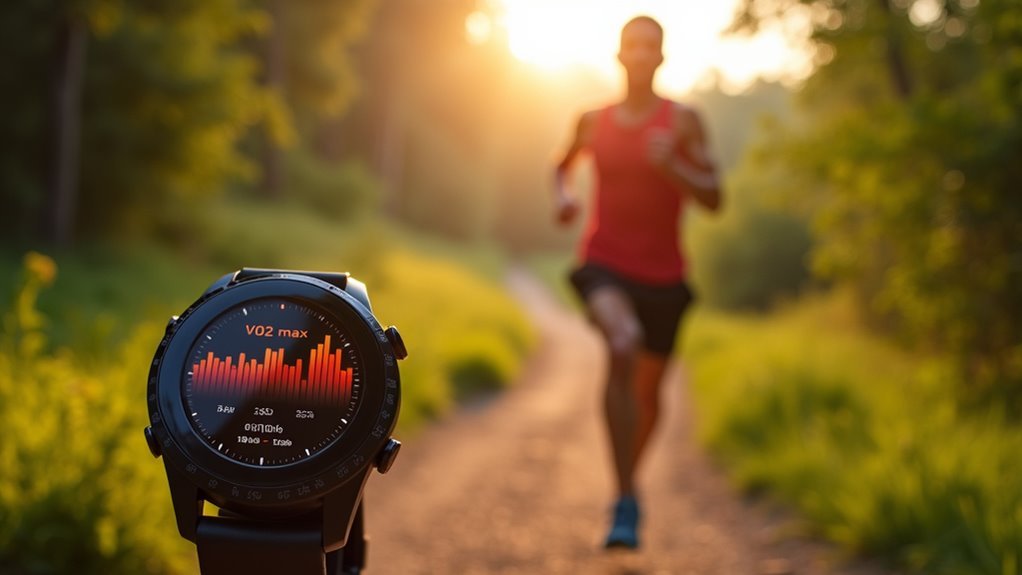
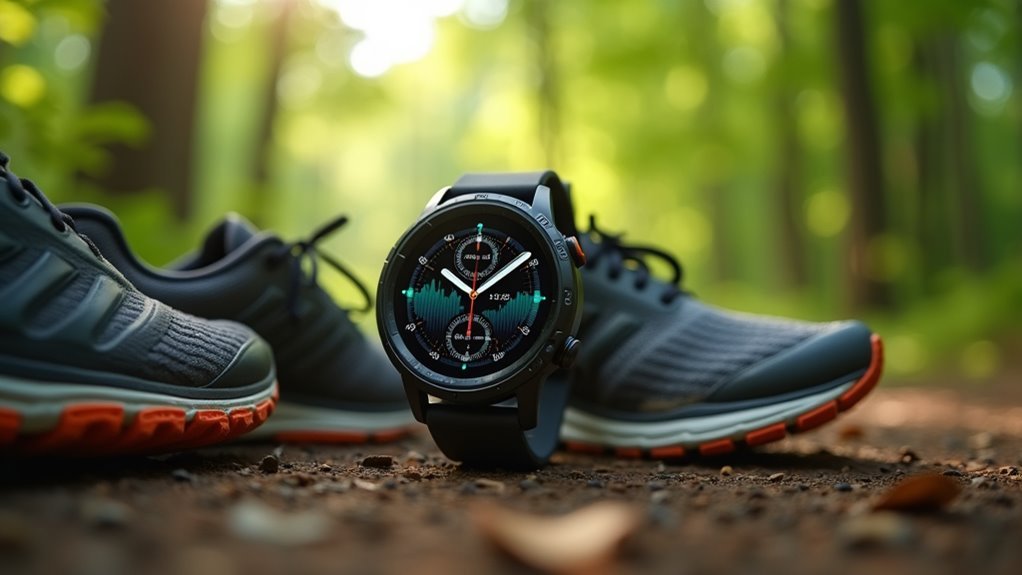

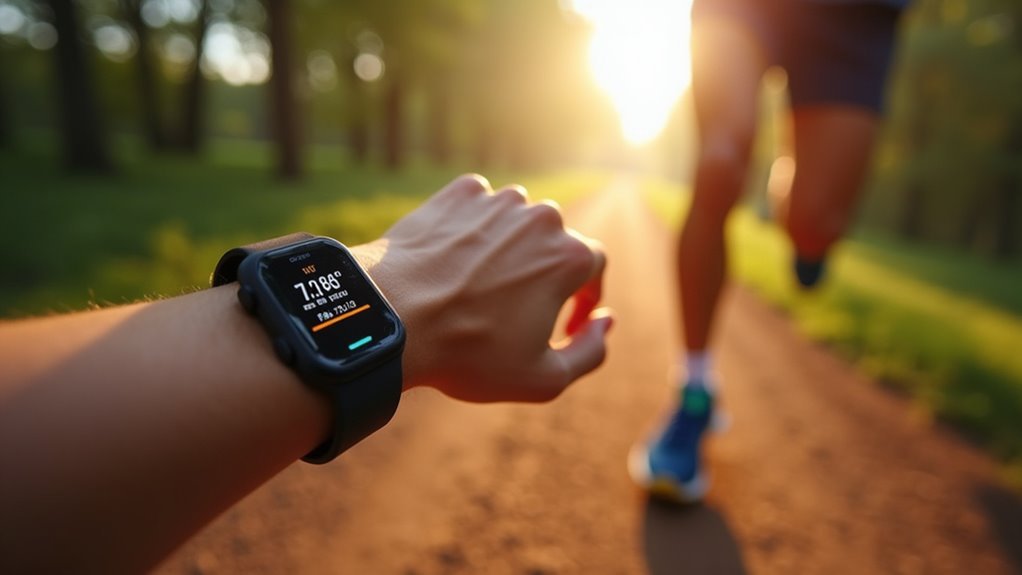
Leave a Reply